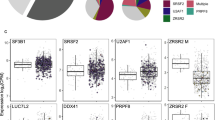Abstract
Cancer progression often involves the disorder of the cell cycle, and a number of effective chemotherapeutic drugs have been shown to induce cell cycle arrest. The purpose of this study was to comprehensively investigate the effects of imatinib on the expression profile of cell cycle genes in the chronic myeloid leukemia (CML) K562 cell line. In addition, we also investigated alternative splicing of the cell cycle genes affected by imatinib, since an important relationship has been shown to exist between RNA splicing and cell cycle progression. Exon array analysis was performed using total RNA purified from normal and imatinib-treated K562 cells. We identified 185 differentially expressed genes and 277 alternative splicing events between the two cell groups. A detailed analysis by reverse transcription-PCR (RT-PCR) of key genes confirmed the experimental results of the exon array. These results suggested that treatment of K562 cells with imatinib shifts the expression and alternative splicing profiles of several cell cycle-related genes. Importantly, these findings may help improve imatinib treatment strategies in patients with CML and may be useful for imatinib resistance research and CML drug development.







Similar content being viewed by others
References
Weinberg R, Lundberg A. Control of the cell cycle and apoptosis. Eur J Cancer. 1999;35(4):531–9.
Vermeulen K, Van Bockstaele DR, Berneman ZN. The cell cycle: a review of regulation, deregulation and therapeutic targets in cancer. Cell Prolif. 2003;36(3):131–49.
Senese S, Lo Y, Huang D, Zangle T, Gholkar A, Robert L, et al. Chemical dissection of the cell cycle: probes for cell biology and anti-cancer drug development. Cell Death Dis. 2014;5(10):e1462.
Alexander A, Keyomarsi K. Exploiting cell cycle pathways in cancer therapy: new (and old) targets and potential strategies. Nuclear Signaling Pathways and Targeting Transcription in Cancer. Springer; 2014; 337–72.
Nishimura N, Furukawa Y, Sutheesophon K, Nakamura M, Kishi K, Okuda K, et al. Suppression of ARG kinase activity by Sti571 induces cell cycle arrest through up-regulation of CDK inhibitor p18/Ink4c. Oncogene. 2003;22(26):4074–82.
Roussidis A, Mitropoulou T, Theocharis A, Kiamouris C, Papadopoulos S, Kletsas D, et al. Sti571 as a potent inhibitor of growth and invasiveness of human epithelial breast cancer cells. Anticancer Res. 2004;24(3A):1445–8.
Uziel O, Fenig E, Nordenberg J, Beery E, Reshef H, Sandbank J, et al. Imatinib mesylate (Gleevec) downregulates telomerase activity and inhibits proliferation in telomerase-expressing cell lines. Br J Cancer. 2005;92(10):1881–91.
Yin T, Wu Y-L, Sun H-P, Sun G-L, Du Y-Z, Wang K-K, et al. Combined effects of As4s4 and Imatinib on chronic myeloid leukemia cells and BCR-ABL oncoprotein. Blood. 2004;104(13):4219–25.
Liu J, Huang B, Xiao Y, Xiong H-M, Li J, Feng D-Q, et al. Aberrant expression of splicing factors in newly diagnosed acute myeloid leukemia. Onkologie. 2012;35(6):335–40.
Prinos P, Garneau D, Lucier J-F, Gendron D, Couture S, Boivin M, et al. Alternative splicing of SYK regulates mitosis and cell survival. Nat Struct Mol Biol. 2011;18(6):673–9.
Ahn E-Y, DeKelver RC, Lo M-C, Nguyen TA, Matsuura S, Boyapati A, et al. Son controls cell-cycle progression by coordinated regulation of RNA splicing. Mol Cell. 2011;42(2):185–98.
Dennis Jr G, Sherman BT, Hosack DA, Yang J, Gao W, Lane HC, et al. David: database for annotation, visualization, and integrated discovery. Genome Biol. 2003;4(5):3.
Yin L-M, Jiang G-H, Wang Y, Wang Y, Liu Y-Y, Jin W-R, et al. Use of serial analysis of gene expression to reveal the specific regulation of gene expression profile in asthmatic rats treated by acupuncture. J Biomed Sci. 2009;16(1):46.
Jonuleit T, van der Kuip H, Miething C, Michels H, Hallek M, Duyster J, et al. BCR-ABL kinase down-regulates cyclin-dependent kinase inhibitor P27 in human and murine cell lines. Blood. 2000;96(5):1933–9.
Chang T-Y, Li Y-Y, Jen C-H, Yang T-P, Lin C-H, Hsu M-T, et al. Easyexon—a java-based Gui tool for processing and visualization of affymetrix exon array data. BMC Bioinformatics. 2008;9(1):432.
Morgan DO. Cyclin-dependent kinases: engines, clocks, and microprocessors. Annu Rev Cell Dev Biol. 1997;13(1):261–91.
Hunter T, Pines J. Cyclins and cancer II: cyclin D and CDK inhibitors come of age. Cell. 1994;79(4):573–82.
Sausville EA. Complexities in the development of cyclin-dependent kinase inhibitor drugs. Trends Mol Med. 2002;8(4):S32–S7.
Kelland LR. Flavopiridol, the first cyclin-dependent kinase inhibitor to enter the clinic: current status. Expert Opin Investig Drugs. 2000;9(12):2903–11.
Du Y, Wang K, Fang H, Li J, Xiao D, Zheng P, et al. Coordination of intrinsic, extrinsic, and endoplasmic reticulum-mediated apoptosis by Imatinib mesylate combined with arsenic trioxide in chronic myeloid leukemia. Blood. 2006;107(4):1582–90.
Majsterek I, Arabski M, Czechowska A, Pytel D, Morawiec Z, Morawiec-Bajda A, et al. Imatinib (Sti571) inhibits DNA repair in human leukemia oncogenic tyrosine kinase-expressing cells. Zeitschrift fur Naturforschung C. 2006;61(11/12):896.
Blasiak J, Gloc E, Pertynski T, Drzewoski J. DNA damage and repair in BCR/ABL-expressing cells after combined action of idarubicin, Sti571 and amifostine. Anti-Cancer Drugs. 2002;13(10):1055–60.
Chang J-G, Yang D-M, Chang W-H, Chow L-P, Chan W-L, Lin H-H, et al. Small molecule amiloride modulates oncogenic Rna alternative splicing to devitalize human cancer cells. PLoS One. 2011;6(6):e18643.
Lundgren K, Allan S, Urushiyama S, Tani T, Ohshima Y, Frendewey D, et al. A connection between pre-mRNA splicing and the cell cycle in fission yeast: cdc28+ is allelic with prp8+ and encodes an RNA-dependent ATPase/helicase. Mol Biol Cell. 1996;7(7):1083–94.
Burns CG, Ohi R, Mehta S, O’Toole ET, Winey M, Clark TA, et al. Removal of a single Α-tubulin gene intron suppresses cell cycle arrest phenotypes of splicing factor mutations in saccharomyces cerevisiae. Mol Cell Biol. 2002;22(3):801–15.
Acknowledgments
This study was supported by grants from the National Science Foundation of China (No. 81271912) and the Education Department of Jiangxi province, China (No. GJJ13041).
Conflicts of interest
None
Author information
Authors and Affiliations
Corresponding author
Additional information
Jing Liu and Jin Lin contributed equally to this paper.
Rights and permissions
About this article
Cite this article
Liu, J., Lin, J., Huang, LF. et al. Differential expression and alternative splicing of cell cycle genes in imatinib-treated K562 cells. Tumor Biol. 36, 8127–8136 (2015). https://doi.org/10.1007/s13277-015-3493-0
Received:
Accepted:
Published:
Issue Date:
DOI: https://doi.org/10.1007/s13277-015-3493-0




